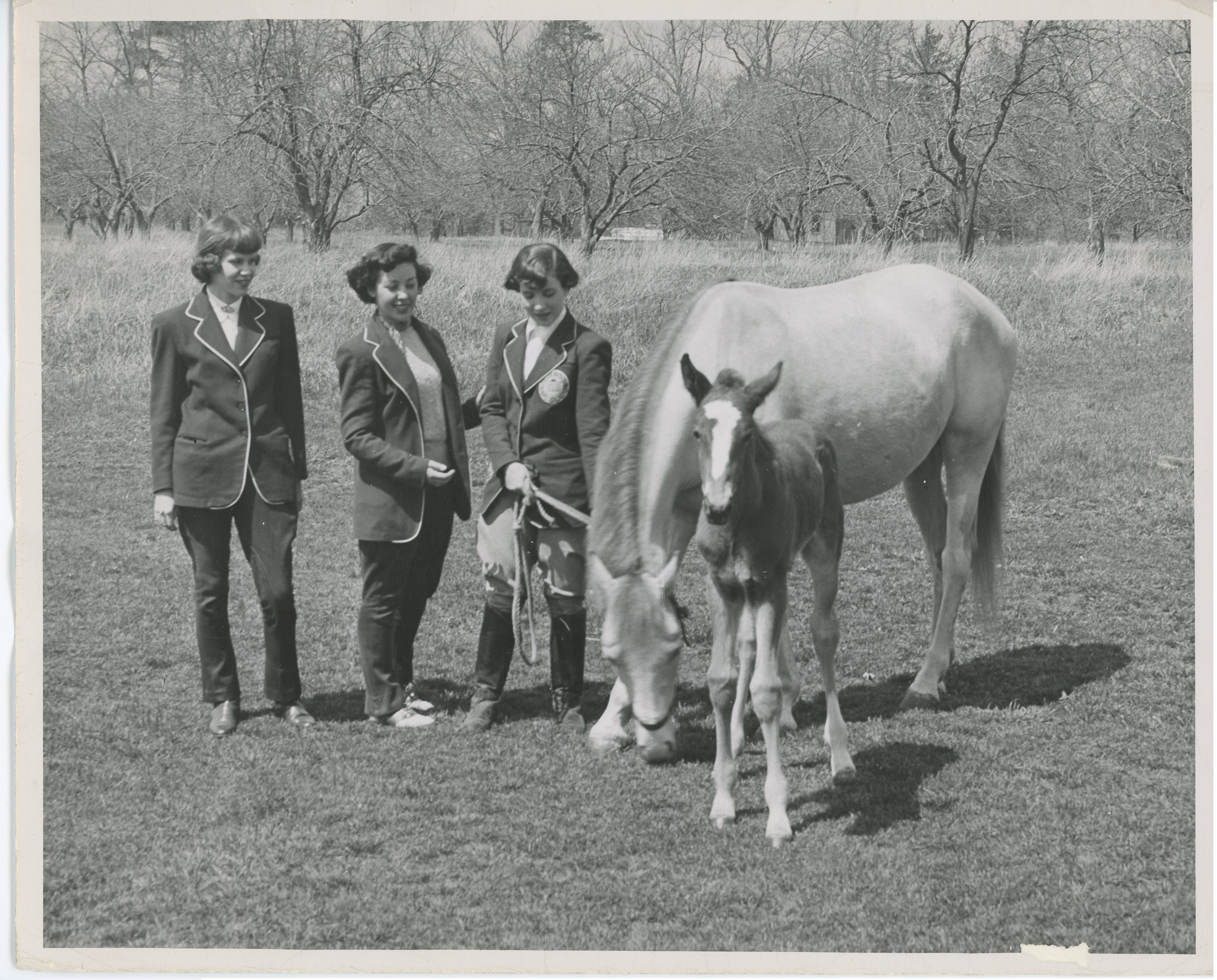Background on Mount Ida College
Brief History of Mount Ida College by Norma Gahl, Spring 1997

Three Mount Ida College students with a mare and foal.
Mount Ida was originally founded in 1899, as a small private secondary school for women. In 1907, a tradition of educational innovation began when George Franklin Jewett, Mount Ida’s first Principal, introduced a new curriculum of “Advanced Studies.” The school flourished under Dr. Jewett’s leadership until death in 1926. Mrs. Abigail Fay Jewett then took over the leadership for the school to be followed by her son-in-law Mr. C. Frederick McGill.
A new era began in 1939 when Dr. William Fitts Carlson bought the title of the Mount Ida School and relocated the school to its present location on the former Robert Gould Shaw II estate. Dr. William Fitts Carlson expanded the curriculum to include new career programs and liberal arts offerings. Enrollment increased from 100 students in 1940 to 342 students in 1948.
In 1960, Dr. William Fitts Carlson was succeeded by a new administration headed by his sons, Dr. F. Roy Carlson as President, and Dr. Edward W. Carlson as Vice President. In 1961, Mount Ida Junior College received associate degree-granting authority from the Commonwealth of Massachusetts. In 1970, Mount Ida was fully accredited by the New England Association of Colleges and Secondary Schools.
In 1976, Dr. Bryan E. Carlson, the nephew of Dr. F. Roy Carlson and the grandson of Dr. William Fitts Carlson, became the sixth president of the College. Mount Ida developed its first comprehensive Master Plan during the late 1970s, and the introduction of baccalaureate programs represented the most profound and fundamental objective in the entire plan. In 1982, the institution’s corporate name became Mount Ida College as the Commonwealth of Massachusetts granted initial baccalaureate degree authority, and the first Senior College curriculum was introduced. In the same tradition of educational innovation that had occurred through the leadership of George Franklin Jewett, Mount Ida pioneered a new curriculum structure for the completion of baccalaureate studies with the introduction of its innovative Tw Plus Two Undergraduate program.
In 1984 Mount Ida established a Two Plus Two undergraduate system that consists of a Junior College Division and a Senior College Division. Upon program completion of an associate degree students may continue to earn a bachelor’s degree. The Senior College Division structure the curriculum to allow students to maximize their credit transfer. Qualified students can transfer all associate degree credits and continue with junior standing in at least one and sometimes more than one baccalaureate program.
In 1984 Mount Ida established a Two Plus Two undergraduate system that consists of a Junior College Division and a Senior College Division. Upon program completion of an associate degree students may continue to earn a bachelor’s degree. The Senior College Division structure the curriculum to allow students to maximize their credit transfer. Qualified students can transfer all associate degree credits and continue with junior standing in at least one and sometimes more than one baccalaureate program.
Upon Dr. Bryan E. Carlson’s leadership, Mount Ida grew significantly in the 1980s by implementing a series of “mutual growth” mergers with three Boston area institutions. In 1987-1988 Mount Ida acquired Chamberlayne Junior College, which was established in 1892 as the Chamberlayne School by Miss Catherine J. Chamberlayne. In 1932 Chamberlayne received accreditation as a junior college. It is now known as the Chamberlayne School of Design and Merchandising of Mount Ida College and offers various two and four year programs in design and merchandising.
The Coyne Electrical and Technical School was established in 1896 by James Coyne. The Coyne Electrical and Technical School remained in Boston and merged with Chamberlayne Junior College. In 1988-1989 Mount Ida acquired the New England Institute of Applied Arts and Sciences, which was established in 1907 by A. Johnson Dodge. After merging with the Boston School of Anatomy and Embalming, Inc., in 1951, the school became the only fully accredited funeral service school in New England. In 1969 Dr. William H. Crawford received degree-granting privileges for an Associate in Science degree in Funeral Service.
Mount Ida’s programs of study, in both the Junior and Senior College Divisions, are in keeping with and serve to reinforce the mission and purposes of the institution. All associate degree programs prepare students for immediate employment and/or for transfer into the Senior College Division or another institution for further study and/or a further degree. Mount Ida’s Two-Plus-Two approach to undergraduate education guarantees eligible junior and community college graduates acceptance of the associate degree as a unit of study and admission into at least one bachelor degree program with full junior year status, in the Senior College division. All bachelor degree programs prepare students for significant employment or career advancement opportunities or for further study at graduate or professional schools.
By the mid-2000s, Mount Ida College was experiencing significant financial challenges due, in part, to deferred maintenance of its campus buildings and systems. The college considered several mergers, none of which were successful, and finally sold the campus in May 2018 to UMass Amherst in order to avoid bankruptcy. UMass Amherst currently operates the Mount Ida campus as its Greater Boston hub offering students access to a variety of enriching educational, professional, and cultural opportunities within the region.

